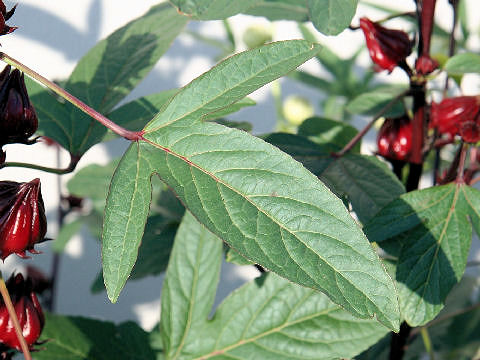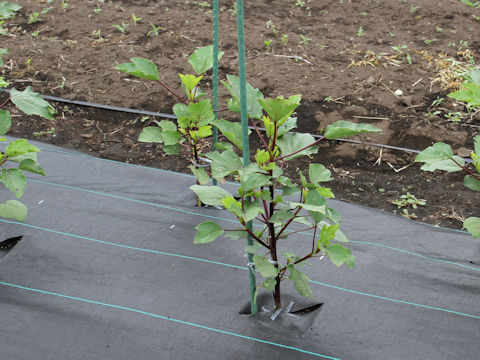
|
|
|
           |
|
|
|
インドからマレーシアが原産ですが、早い時代にアフリカに導入されました。現在では熱帯・亜熱帯地域で広く栽培され、また帰化もしています。茎はふつう赤みを帯び、高さは2〜3メートルになります。葉は楕円形で3深裂し、互生します。短日植物で、9月から11月ごろ、葉腋にクリーム色の花を咲かせます。花弁の基部は暗赤色です。萼片は暗赤色で肥厚し、これが食用となります。ジャムや西洋料理のソース、ハイビスカスティーなどに利用されます。、 花が咲いて果実が十分に大きくなるには12℃前後の気温が必要なので、東北地方南部の露地栽培では開花せず、寒さで枯死してしまいます。 |
|
|
アオイ科フヨウ属の一年草または多年草で、学名は Hibiscus sabdariffa。英名は Roselle。 |
|
|
The Roselle (Hibiscus sabdariffa) belongs to Malvaceae (the Mallow family). It is an annual or a perennial herb that is native to India through Malaysia. It was introduced into Africa in early days. Nowadays, it is cultivated widely in tropical and sub-tropical areas, and also naturalized in these areas. The stem is tinged reddish and can reach 2-3 m in height. The leaves are deep trilobate and alternate. This herb is a short day plant and blooms creamy flowers on the axiles from September to November. The petals have dark red bases. The calyx lobes are dark red and thickened. They are used for food; jam, sauce and herbal tea. Since temperatures of around 12°C are required for the flowers to bloom and the fruit to grow large enough, the plant does not flower in open fields in the southern Tohoku region and dies in the cold. |
|
|
[上・中1] 愛知県安城市「デンパーク」にて、2007年11月02日撮影。 [中2〜中4] 大阪府四條畷市清滝中町にて、2006年10月15日撮影。 [中5〜中7] 福岡市中央区「福岡市植物園」にて、2017年10月06日撮影。 [中8] 宮城県川崎町支倉にて、2020年06月22日撮影。 [中9] 同上にて、2020年08月24日撮影。 [下] 同上にて、2020年10月13日撮影。 |

|
|
Shu Suehiro |